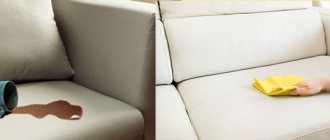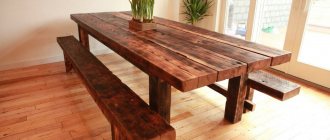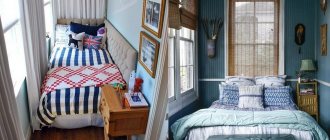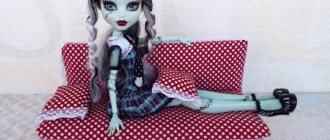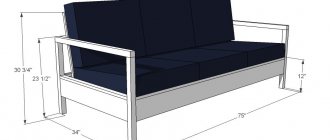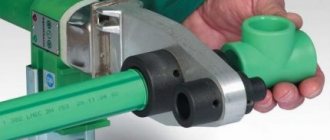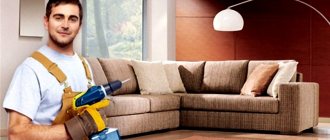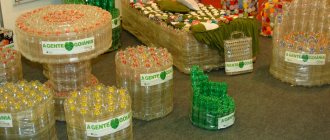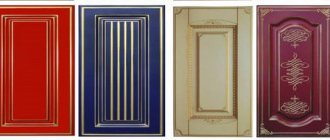Manufacturing instructions with drawings
- Drawing of a roll-out sofa seat
- Reclining drawing
- Drawing of a sofa box
- Pillow
- Drawings of the main back of the sofa
- Assembling the sofa
Introduction: On the furniture forum sdelaimebel.ru, user Eskander shared his experience in making children's sofas, for which many thanks to him.
I found this instruction interesting for a wide range of readers and, with the permission of the author, I am posting it here. This is the only material in this section for which I am not the author, but only the editor. This sofa model is mass-produced by the author in production, but it is quite possible to make such a children’s sofa yourself, with your own hands at home. In this particular case, we are considering a sofa based on a roll-out Bonnel spring block with a folding headboard segment. Instead of springs, you can use foam rubber in a children's sofa. This is what a children's sofa you can make yourself looks like:
What are the shapes and sizes of children's sofas?
Shape and size may vary. It depends on the age of the child and the design. By age, sofas are divided into:
For babies. The difference between this piece of furniture and others is that it does not have sharp corners. All edges are rounded. It is also better not to leave hard surfaces on it. Everything should be upholstered with soft material. Children's options must have sides to protect them from falling at night. Their other function is protection from cold air currents.
Furniture for teenagers. In such decisions, attention should be paid to design aspects. The child can be involved in this process. Let him make his own choice in favor of color, fabric, pattern. Safety elements are important, but not as important as for a baby.
By design, the following options can be distinguished:
Folding. Another name for them is “folding beds”. A simple and common type of design.
Retractable. This type of mechanism is also called withdrawable. The retractable part can be equipped with drawers in which bedding is stored.
Corner sofas. Among the furniture for children there are corner sofas. They save space and are very spacious.
Important! The sizes of children's sofas are very different. But there are standard sizes: with a mattress length of 186, 190, 195, 200 cm, width from 60 to 150 cm with an interval of 10 cm.
Drawing of a roll-out sofa seat
- The support frame (position 15) with plastic supports (14) is attached to the support frame fastening bars (12) using 50 mm SHSGD self-tapping screws.
- The synthetic winterizer (1) is attached to the polyurethane foam point-by-point, using “Tapicer” foam rubber adhesive (if not available, you can use regular “Moment” in tubes or “Titan” type ceiling tile adhesive).
- PPU 30 mm. (2) attached to heat-pressed felt (3) pointwise, using “Tapicer” foam rubber adhesive (you can, again, “Moment” or “Titan”).
- Heat-pressed felt (3) is attached with a fold to the Bonnel spring block by stitching with a needle and nylon thread (fishing gear) with wide ties.
- Spring block “Bonnel” L. x W. x H. = 1330 mm. x 660 mm. x 100 mm. /1 r./ (one frame) (position 4) we fasten along the perimeter of the frame bars with a stapler (staple No. 16) two staples on the right and left of each spring, corner springs - on 6 staples (right, left and corner). In the absence of a stapler, you can use a hammer and 32 mm nails, one nail per spring, corner springs - 2 (we hammer the nails halfway, then bend them).
- Fiberboard 2.5 mm. the rigid base (11) is secured around the perimeter of the frame bars (6) (9) and the span bars (10) with a stapler (bracket No. 16) or 25 mm SHSGD. (at worst - with the same 32 mm nails.).
- Spring-loaded flooring - heat-pressed felt (11) is attached to the fiberboard using glue or staples.
- Frame (6) (9) (10) - pine bars placed on edge, connected with a tenon (possibly without a tenon, with 75 mm SHSGD self-tapping screws. 2 pieces per end with simultaneous gluing of the ends with PVA wood glue).
- PPU 20 mm. (5) glue from the top to 30 mm polyurethane foam. (2) and from below - to the plane of the frame bars along the perimeter (or with a stapler, staple No. 10).
To reduce time costs and the range of materials used, you can:
- use polyurethane foam with a thickness of 100 mm. instead of a Bonnel spring block and heat-pressed felt.
- Do not use tenon joints for frame bars.
- use chipboard or laminated chipboard instead of the support frame (15) and supports (14), which are screwed using a 35 mm SHSGD. to the plane of the frame block (6).
Wheel support No. 493:
Options for attaching the Bonnel spring block to a rigid base (using 32 mm nails and No. 16 staples); option of attaching heat-pressed felt to the Bonnel spring block using nylon thread:
Please note that the photo above shows the mounting of the spring unit not on a children's sofa, but on a sofa of a different model. But the principle is the same: first the batting, then the spring block is nailed, and the top is sheathed with felt. And then the foam rubber is glued.
DIY sofa
Making furniture not in production, but at home, is not as difficult as it seems at first glance. For example, to create a sofa for a child, you need to buy chipboard, beams, mechanisms that will help lay out the structure, upholstery and filling. Don't forget that the fabric for a children's sofa should be bright and attractive to the child.
Design requirements
1. Before starting construction, you need to thoroughly study the drawing of a children's sofa - this will greatly facilitate your task. 2. When choosing materials, remember that the better quality they are, the longer the sofa will last. Moreover, the smaller the child, the more likely it is that the baby will jump on the sofa, so it must be strong and reliable. 3. A children's sofa should be easy to unfold and assemble, and its mechanism should be safe. 4. If you have already decided to make a sofa yourself, then you can decide whether you need drawers for linen or not. 5. You should not make a very small sofa - remember that children grow very quickly.
Reclining drawing
The technology is similar to the manufacture of a roll-out seat. Differences:
- In place of 30 mm polyurethane foam. (position 2) 20 mm polyurethane foam is used. in order to compensate for the overall thickness of the pillow and prevent a difference relative to the plane of the roll-out seat during transformation (since fiberboard (11), 10 mm polyurethane foam (12) and padding polyester are added from the bottom).
- The frame bars are covered from the bottom with fiberboard (11), onto which 10 mm polyurethane foam is glued. and padding polyester.
- The furniture fabric cover is not nailed with staples to the frame bars, but is put on and fastened using a “Zipper” lock, after which a card loop No. 538 zinc (2 pcs.) is screwed to the folding backrest using self-tapping screws ШСГД 50 mm. according to pre-made markings (chalk on furniture fabric).
The article belongs to the site NovaMebel74.ru
Card loop No. 538 zinc:
To reduce time costs and the range of materials used - (see ROLL-OUT SEAT) similarly.
Drawing of a sofa box
- The end and side boards (1) (2) are made of pine, connected with a tenon (possibly without a tenon, using self-tapping screws ШСГД 75 mm, 3 pieces per end, while gluing the ends with PVA wood glue). Instead of boards, you can use 16 mm. Chipboard or plywood.
- The fiberboard of the bottom is attached around the perimeter and to the bottom block (6) with bracket No. 16 (can be 25 mm SHSGD or nails). The bottom can be decorated with fabric, or instead of the usual fiberboard, you can use a treated one (laminated or painted). When decorating the bottom with fabric, it is necessary to fix the box boards at an angle of 90 degrees. (checking the equality of the diagonals), upholster with fabric with slight tension around the perimeter and then install and secure the fiberboard bottom.
- The guide bars of the rollers (3) are attached to the planes of the side boards (2) with 50 mm SHSGD self-tapping screws. The bars have cutouts for fixing the rollers and at the same time allow you to remove the load from the rollers (in this case, the rollers work only during transformation; in other cases, the load is taken not by the rollers with guides, but by the box boards and the bars of the roll-out seat frame).
- The support bars (4) are attached to the plane of the side boards (2) with 50 mm SHSGD self-tapping screws. Plastic supports ST 35 ШБ (35mm) (5) are screwed into the support bars (from the bottom).
- PPU 10 mm. (8) is attached to the boards (2) using bracket No. 10 (can be glued point by point with glue)
To reduce time costs you can:
- Do not use tenon joints on workpieces.
- use laminated chipboard or plywood instead of solid wood blanks.
- do not use cutouts in the guide bars of the rollers (3); you can install straight bars, securing on them any clamps that prevent the rollers from rolling back
Preparing the necessary materials
So, before you start working on furniture, draw a rough sketch of the sofa for yourself on a piece of paper. Remember that the simpler the shape, the easier it will be to make. Therefore, try to simplify the furniture as much as possible, especially if this is your first time dealing with such an activity. In addition to the sketch, you will need:
Figure 2. To ensure that the foam rubber does not lose its softness, you only need to apply glue along the edges of the pattern.
Pay special attention to cardboard and glue. Please note that it is advisable to use pieces of cardboard of equal thickness (at least 1 cm). Then the load on the furniture will be uniform. It is better to use silicate glue or even superglue. You can also use regular PVA, but then you will have to press the parts together for a long time until they set well.
Return to contents
Pillow
In my case, a cover made of furniture fabric with a “Zipper” lock with a linear Velcro fastener was used. Pillow size (finished) 400 x 600 mm. The filler is Super Pooh balls, which we place in a low-density spunbond case and then stitch it on a sewing machine, cutting off the excess with scissors. You can use other types of tightening - point or using buttons. As a filler, you can use Super Pooh comb (holofiber, as we did when stuffing pillows for the back of a corner sofa). Many (to save money) use a mixture of foam rubber crumbs and padding polyester; in this case, it is better to sheathe a spunbond cover with padding polyester in several layers. The cover for the filler (instead of spunbond) can be sewn from calico fabric.
Making a cover
To sew a cover for a children's sofa with your own hands, you need to acquire the following materials and tools:
- textile;
- pins;
- measuring tape;
- chalk or pencil;
- scissors;
- sewing machine.
Taking measurements
The first step is to measure the children's sofa, dividing it into separate sections. Even if the furniture has a non-standard shape, the cut pieces should still be rectangular. After this, two armrests, a backrest and a seat are measured, that is, in the end you should get six rectangular templates.
When taking measurements of a children's sofa for a nursery, you should remember that it should be measured as a rectangle, regardless of its shape. All measurements must be transferred to paper, adding 5-7 cm on each side for seams. At the end, you need to cut out the resulting patterns.
Working with fabric
The fabric used to create the upholstery must be clean and ironed. You should lay it out on a completely flat surface, lay the pattern on top and cut out the required areas. After this, you need to lay out the pieces on the sections of the sofa with the wrong side up, and then fasten the pieces of fabric to the sofa using pins.
Without removing the fabric from the surface of the sofa, you need to connect them with a contrasting thread to each other. The cover should fit perfectly on the sofa once you take into account all the angles and curves. After this, the excess fabric is cut off and the seams are sewn on a machine. After this, the cover must be turned right side out and put on the sofa. If necessary, you can make adjustments by sewing additional seams and removing excess fabric.
Drawings of the main back of the sofa
The main back is made of 16 mm plywood. We drill holes for the bolts securing the backrest to the frame (d. 8 mm) according to the template. At home, you can do without a template; you must first attach the back to the box and temporarily secure it with nails or clamps, simultaneously drill the back with the box according to the pre-applied markings). The roller that frames the contour of the back from above and from the sides is made of a 30 mm polyurethane foam strip, which we wrap around the edge of the plywood and secure with staples No. 10 (we beat the staple in a line, without gaps). On the front side of the plywood plane we glue 10 mm polyurethane foam, pre-cut to the shape of the back. The foam roller framing the back is upholstered with a strip of furniture fabric. Lastly, we install and nail (staple No. 10 into the line under the edging) an insert of companion furniture fabric made with edging along the contour (you can sew in a clothesline). The edging is needed to hide the staples. The back surface of the back can be covered with spunbond or calico. To simplify the design, you can do without rollers and inserts, just cover the plywood with 10 - 20 mm foam rubber. and upholster with furniture fabric.
Assembling the sofa
— Installation of the reclining backrest – install the reclining backrest in the “sleeping” position, aligning it with the side bars of the box and the end of the roll-out seat, fasten the card loops to the end board of the box with 32 mm SHSGD self-tapping screws. (8 pieces for 2 loops). — Installation of the main backrest - to the frame is carried out with bolts M 8 x 85 (+ washers d. 8 with an increased field, 2 pcs. per bolt). Before installation, it is necessary to install bars 30 x 60 x 200 to the back wall of the box (or to the main back - as it suits you), securing them with self-tapping screws (drill holes for the bolt in the bars along the existing ones). These bars are necessary to distance the main back from the box and the roll-out seat, so as not to have a braking effect with the plane of the back relative to the roll-out seat during transformation.
Popular materials:
- Making decor for the armrest
- Sofa reupholstery in photographs
- How to make a corner sofa with your own hands
You can leave your comments and questions in the Guest Book
What is the most important thing in making a sofa for a child?
Making a children's sofa with your own hands is quite simple, especially if you have at least a little experience in carpentry. But, even if you are new to this area, do not despair, you can still make excellent furniture for your baby, according to your own preferences. The main thing is to use the correct drawings and follow them, and the big plus is that today on the Internet there are many photos of different furniture models.
Sofa diagram
